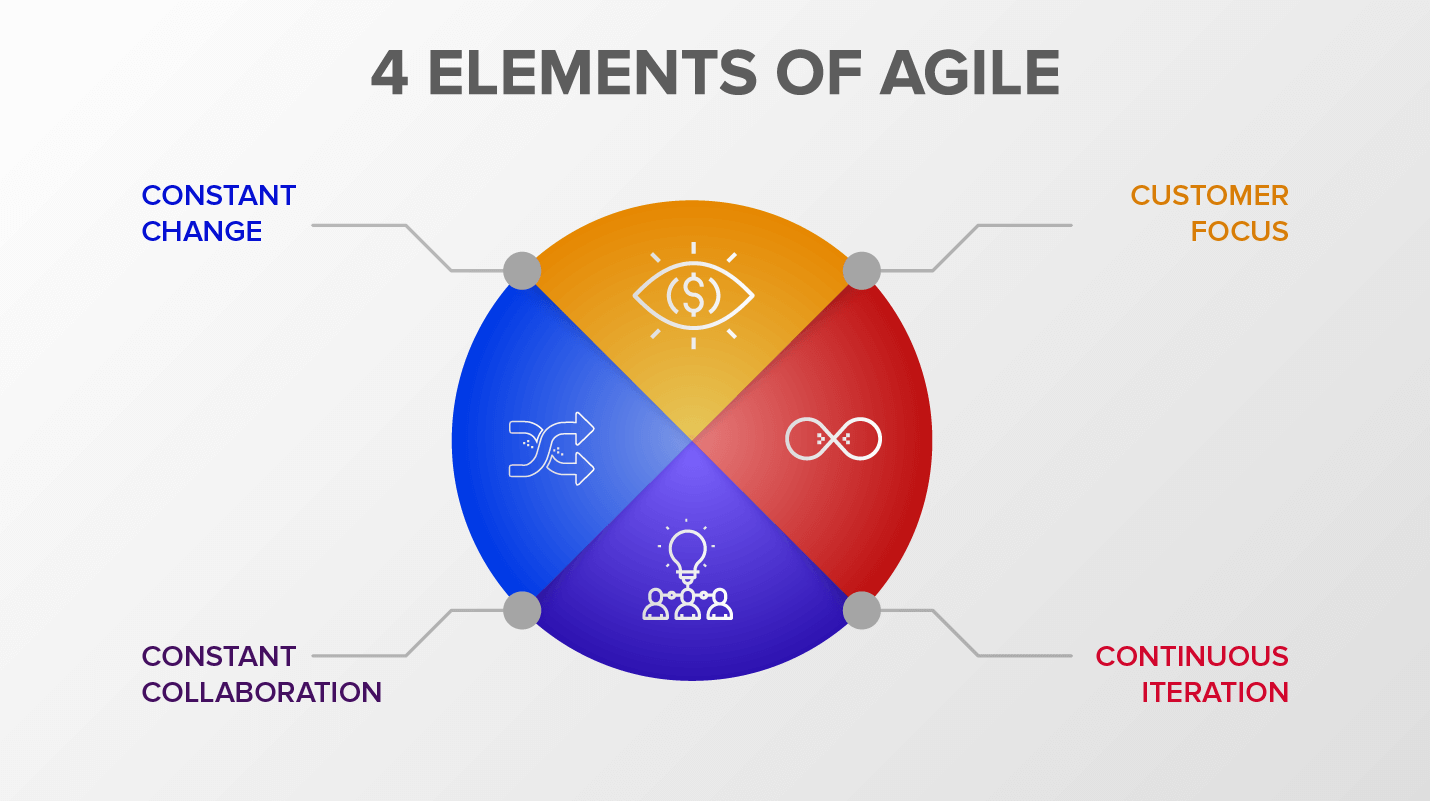Marketing work is never done. At any given moment, you probably have multiple omnichannel campaigns running alongside the daily grind of managing all the deliverables needed to launch new engagement or win-back campaigns. And then, to top it all off, the only thing everyone wants to talk about is the latest movie in theaters.
You literally cannot afford to have a process that takes two weeks to build an email, have it approved it, test it, then deploy. By the time you launch, everyone’s moved on to talking about the latest hyper-casual game. And suddenly your movie-themed campaign is rendered irrelevant.
How does one manage omnichannel marketing campaigns at this pace?
There are ways for growth and marketing teams to deal with the constant onslaught deadlines while coping with constantly changing customer needs. And one of the most potent methods available is Agile marketing.
What is Agile Marketing?
Agile marketing is the use of data to continuously improve on your campaigns by deploying tests more quickly, evaluating results, and rapidly introducing the data-backed revisions.
This is an offshoot of Agile – a project management method that was primarily created for the development of software but which the larger business world adopted once it became obvious how effective it was in streamlining processes and delivering work.
Agile marketing is simply using the Agile philosophy within your marketing campaigns and tactics so that you create value for your users at every step, no matter how needs or tastes change.
To better understand it, we need to find out where it started.
The Genesis of Agile
Agile began in the early days of software development when multi-million-dollar programs would be shipped so late and so over budget that customers’ needs had changed by the time the software was released.
Thus, 17 developers gathered in 2001 and put their heads together to find a better way. They came up with the Agile Manifesto – a formal document outlining 12 principles for building software efficiently so that it could provide value to customers, ship on time, and meet the budget.01
The Key Pillars of Agile
The Agile Manifesto was not a prescriptive tutorial on how to deliver software. It merely listed guiding principles that helped workers prioritize tasks. They were, in effect, guidelines on how to be an effective, and customer-focused team.
In general, those guiding principles can be condensed into four pillars that all Agile methodologies share:
- Customer focus: If it doesn’t serve the end user, it’s not a priority
- Continuous iteration and improvement: Doing rapid cycles of work and improving performance with each cycle
- Constant change: Being able to pivot quickly to meet the changing needs of customers
- Constant collaboration: Communicating with stakeholders/customers to better answer their needs
When you put the principles of the above idea into action, you have a frame upon which to hang your process and tools.
The Benefits of Agile Marketing
But why learn something new like Agile? And why subject your marketing/growth team to a radical change in the way you do things?
Because the benefits – to both customers and your own marketing team – are huge.
- Customer Focus: According to Forbes and CMG, 80% of CMOs said that Agile helped them deliver a better product that is more relevant to their end user.
- Productivity: 87% of Agile CMOs have found their teams to be more productive following the transition to Agile marketing. (Forbes)02
- Efficiency and Flexibility: 36% of Agile marketing teams can release things faster, and 53% can change gears quickly when feedback demands it.03
- Morale: According to a recent survey, Agile contributes to greater work satisfaction. 63% of marketers who practiced Agile were very satisfied with their work versus only 26% in those who do not use Agile methods.04
FYI: Agile Has Many Methods
One thing to remember: since the Agile Manifesto wasn’t prescriptive, there has been an abundance of methodologies that popped up over the years to better codify the Manifesto’s principles into an actual process.
Thus you’ll hear about some of the more popular methodologies such as Scrum, Lean, or Kanban.
But there are also many others that are less mentioned outside of project management experts. Those other methods include: Crystal, Six Sigma, Feature Driven Development, Extreme Programming (XP), Dynamic Systems Development Method (DSDM), and more.
So How Does One “Do” Agile Marketing?
After all that information, what are the actual nuts-and-bolts of turning your growth team into an Agile team?
Well, it depends on the methodology you choose to follow.
For this article, we’ll assume you go with the Scrum method, arguably the most popular Agile process around. Here’s what you would need to have to kick things off:
01. The Agile Team
First off, you need the right number of team members. The team should be large enough to be effective at implementing a complete marketing campaign from scratch. But it also needs to be small enough so that everyone is accountable to one another.
Ideally, this means anywhere from a minimum of three to a maximum of 10 people. If you have more than that, your meetings become unwieldy, and the work gets bogged down by too many cooks.
An Agile team will require people to take on some basic roles:
- Product Owner: Someone needs to own the scope of all work within a sprint. This person can clarify all questions about which tasks to prioritize.
- Scrum Master: Someone will facilitate all standup meetings and remove obstacles so the team members can get their work done.
- Team members: This is the rest of the team. You’ll need someone who can write the content, design the graphics, handle the web components, analyze the data/analytics, and take care of email and communication. Sometimes all this can be done by just three or four people. But it may take more.
02. The Sprint
For Agile to work, it needs to be done in quick cycles, called “sprints.” A marketing sprint is typically a week or even two weeks long. Sprints are this length so they give the team enough time to get a sufficient amount of work done, but shouldn’t be long enough for projects to drag on needlessly.
During every sprint, deliverables are agreed upon before work commences. These are due by the end of the sprint and cannot be revised. All new requests for work will be tackled in the next sprint, using a defined intake process.
03. The Daily Standup
Part of the Agile experience is building a spirit of transparency among team members. This is done via the daily standup meeting, which should last 10-15 minutes only. The Scrum master ensures meetings stick to this limit.
The standup meeting is conducted without sitting down, so no one gets too comfy and starts talking lengthily. And each member gets two to three minutes maximum to go over:
- what they did yesterday,
- what they intend to do today, and
- whether they’re experiencing any roadblocks to getting their work done (e.g., waiting on approval, or waiting on a campaign element still unfinished).
The Scrum master then takes on the mentioned roadblocks and will work on clearing them so that work can continue.
04. The Task Board
To track what’s being done and what’s coming next, an Agile team will make use of a visual task board – either a physical or virtual Kanban board separated into columns such as (but not limited to): backlog, in process, on hold, and done.
Each task is on an individual card (or sticky note) and is moved through the columns as each phase of the work gets done.
The idea is to break down a large campaign into smaller, manageable chunks so you get it done incrementally.
05. The Kickoff and the Retrospective
Every sprint is bookended by two meetings that help the Agile process improve as it goes along.
The spring starts with a kickoff meeting where the Product Owner describes objectives and outlines what needs to be done. Team members then pick the tasks they want to focus on that fall under the sprint’s goals and assign themselves to those tasks.
At the end of the sprint is the retrospective meeting, where the scrum master goes over the data from the sprint to see what was done effectively, what test results were, what worked and what didn’t. It is also at this meeting that each team member shares the most important lessons learned from the sprint that just ended. Discussing and then documenting the process helps the team improve their work, their process, and their collaboration skills.
Final Notes
Consider this a primer on Agile marketing and not a comprehensive manual. There are many more levels to it than can be covered in a single post. Feel free to find them online.
The point of this entire process is not to change just for change’s sake. It’s to improve how you work as a team so you can answer customer needs better and faster. So keep these guidelines in mind:
- Your goals as an Agile team should align with larger business objectives. It’s the product owner who takes the lead on this, but all team members should know what the goal is for any sprint. And how it lines up with the larger marketing department’s KPIs.
- You need to measure and look at the data. Part of the process is experimenting and then looking at the results of your tests. What worked? The data will show if your campaign was a success. If nothing is measured or tested, nothing changes.
- You need to iterate to constantly improve. If you use the data you gather and apply your lessons learned after every sprint, then the team’s work will improve over time.

A Complete Guide to User Engagement
Shivkumar M 
Head Product Launches, Adoption, & Evangelism.Expert in cross channel marketing strategies & platforms.
Free Customer Engagement Guides
Join our newsletter for actionable tips and proven strategies to grow your business and engage your customers.















































